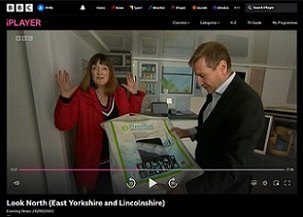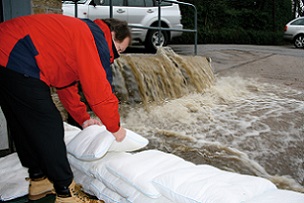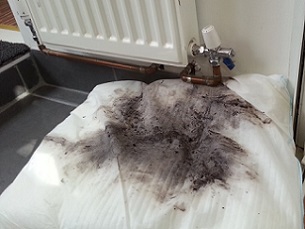 Flood expert Mary Dhonau on BBC TV news talking about FloodSax alternative sandbags
Flood expert Mary Dhonau on BBC TV news talking about FloodSax alternative sandbags
 FloodSax in action keeping torrential floodwater out of a warehouse preventing hundreds of thousands of pounds damage
FloodSax in action keeping torrential floodwater out of a warehouse preventing hundreds of thousands of pounds damage
 Multi-purpose FloodSax are ideal at soaking up water leaks inside, especially in hard-to-reach places
Multi-purpose FloodSax are ideal at soaking up water leaks inside, especially in hard-to-reach places
TV news turns the spotlight on FloodSax alternative sandbags
FloodSax alternative sandbags have been featured on TV as a prime way to tackle flooding.
The East Yorkshire and Lincolnshire region of Look North news did a major interview with flood expert Mary Dhonau who told them how effective FloodSax are at keeping floodwater out of homes and businesses.
The areas are among the most vulnerable to flooding in the UK and Mary had taken a floodmobile roadshow there to show people the latest anti-flooding gadgets which consign sandbags to history.
In short, Mary, who has been flooded out of her home in the past, hates them with a passion.
She said: “When a flood happens everyone shouts for sandbags but they simply don’t work. They are also heavy, unsustainable and environmentally unfriendly. Sand escaping from sandbags can block drains too, making the potential for floods to be worse the next time.
“Sandbags do more harm than good and it frustrates and upsets me to see them continually being used as a go-to solution when they don’t work.”
In stark contrast to sandbags, FloodSax are very light and easy to move in their dry state, are space-saving to store and deploy and don’t contain sand. They have a gelling polymer inside which absorbs water so once immersed in water they expand to become instant sandbags but without the sand.
In their dry state they are large and very flat so are ideal at soaking up leaks, spills, drips and floods, especially in hard-to-reach places.
The fact that they can be used both indoors and outdoors makes them one of the most flexible anti-flood devices on the market.
Mary, who is affectionately known as Mary Queen of Floods, is an expert on what prevents floods.
She’s often on tour around the country in her floodmobile showing people the best ways to prevent flooding in the first place and also what can be done inside your home or business to stop damage should the floodwater get in.
And she has shared her ultimate flooding 1, 2, 3.
Step 1: Have a specialist flood door to prevent the water getting in.
Step 2: Put FloodSax on the floor inside the door to soak up any water that seeps in.
Step 3: Invest in a portable water pump to get rid of the water quickly down to 1mm … and then use FloodSax again to soak the rest up.
Mary said: “To get the flooding kite mark anti-flood devices must not leak more than a litre of water in an hour.”
This means that water can and does seep in through many anti-flood devices.
Mary’s floodmobile features everything from FloodSax sandless sandbags, non-return valves in pipes and air brick covers to waterproof flooring and an ingenious cavity membrane system to stop water coming through the walls.
Find out more about FloodSax at http://www.floodsax.co.uk/